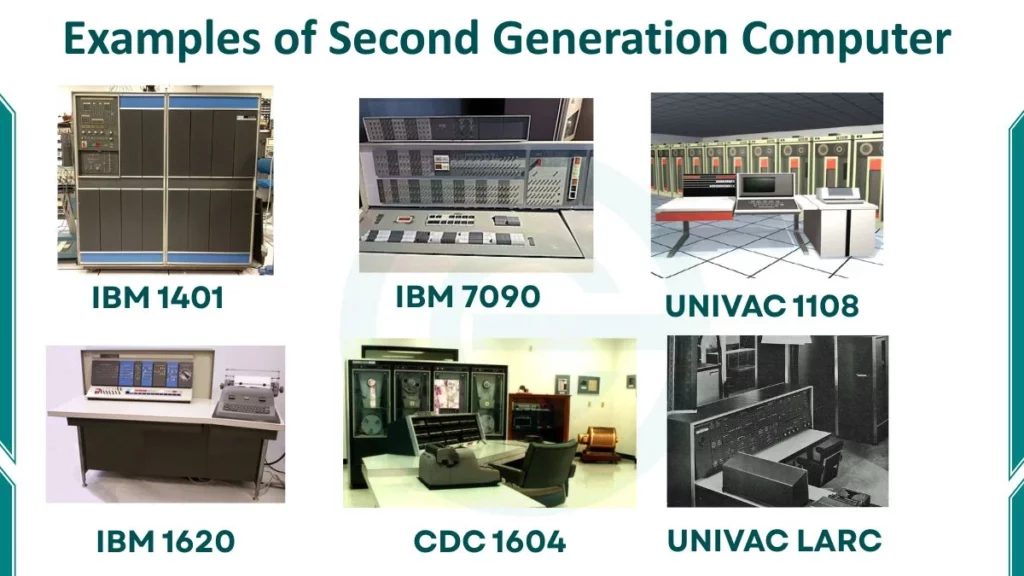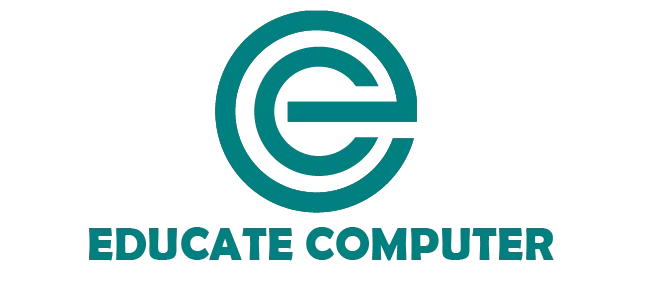Examples of Second Generation Computers include IBM 1401, IBM 7090, UNIVAC 1108, IBM 1620, CDC 1604, and many more that we will look at in detail below.
Second-generation computers are an important part of computer history. They were developed between 1956 and 1963. These computers use transistors instead of vacuum tubes, which makes them faster, smaller, and more reliable.

Second Generation of Computer Examples
Here are 10 most popular 2nd generation of computer examples:
1. IBM 1401
The IBM 1401 is one of the most famous second generation computers. It appeared around 1959 and quickly became popular in offices and business organizations.
Key Features:
- Uses transistors instead of vacuum tubes. This making it smaller and more reliable.
- Has magnetic core memory for faster and safer data storage.
- Performs batch processing, where many jobs are processed together.
- Supports COBOL and FORTRAN programming languages, making it flexible for both business and scientific work.
Importance:
The IBM 1401 became the most used business computer of the 1960s. Companies use it for data processing, billing, and payroll. It helps replace manual accounting systems with automatic data handling.
2. IBM 7090
The IBM 7090 is a scientific and engineering computer and an upgraded transistor version of the earlier IBM 709. It was released in 1959 and represents a big step forward in computing speed.
Key Features:
- Fully transistorized design, offering better performance than tube-based models.
- Has high processing speed for complex scientific calculations.
- Uses magnetic tape for data storage.
- Supports FORTRAN (Formula Translation), one of the first high-level languages designed for science and mathematics.
Importance:
The IBM 7090 is widely used in space research, nuclear science, and engineering simulations. NASA relies on it during early space missions, including the Mercury and Gemini projects.
3. UNIVAC 1108
The UNIVAC 1108 was introduced in 1964. It was built by Sperry Rand Corporation. While released slightly later, it still represents the transistor-based design of the second generation but begins to show transitional features toward third-generation systems.
Key Features:
- Has 36-bit architecture for handling large data.
- Uses magnetic core memory for primary storage.
- Supports multi-user time-sharing, letting several people use it at the same time.
- Compatible with FORTRAN and COBOL, increasing programming efficiency.
Importance:
It enhances multitasking and system sharing. It serves as a bridge between second and third-generation computers. The UNIVAC 1108 shows how computing moves from single-user systems toward the concept of shared computing environments.
4. IBM 1620
The IBM 1620 is also known as the “CADET” (Computer with Automatic Decimal Electronic Technique). It was released in 1959 for educational and research use.
Key Features:
- Affordable and transistor-based, making it suitable for schools and research labs.
- Supports symbolic processing for mathematical and logical operations.
- Compatible with FORTRAN, helping students learn real-world programming.
Importance:
The IBM 1620 is often used in universities and technical institutes. It gives students their first practical experience with computers and becomes one of the most common teaching computers of the era.
5. CDC 1604
The CDC 1604 was developed by Control Data Corporation in 1959. It is one of the first fully transistorized computers to reach commercial success.
Key Features:
- High processing speed compared to earlier models.
- Uses magnetic core memory and punch cards for data input.
- Can handle large and complex numerical data efficiently.
- Supports assembly and FORTRAN languages for programming.
Importance:
The CDC 1604 is mainly used for military and scientific applications. It becomes a powerful tool for weather prediction, defense research, and data analysis.
6. UNIVAC LARC (Larger Automatic Computer)
The UNIVAC LARC (Larger Automatic Computer) is built for scientific research and advanced engineering tasks. It was introduced around 1960. It is among the first computers to use parallel processing.
Key Features:
- Fully transistorized design.
- Supports parallel processing, allowing it to perform multiple calculations at once.
- Designed for high-speed scientific work and data analysis.
- Supports early programming systems for engineering computation.
Importance:
The U.S. Navy uses the UNIVAC LARC for nuclear simulations and complex scientific research. It is one of the most powerful scientific computers of its time.
7. IBM 7094
The IBM 7094, introduced in 1962, is an improved version of the IBM 7090. It offers higher speed and better data handling for technical applications.
Key Features:
- Uses floating-point arithmetic, improving performance in engineering and scientific work.
- Supports FORTRAN IV, a newer and more advanced version of FORTRAN.
- Features larger memory and faster processing speed than earlier models.
Importance:
The IBM 7094 is used in NASA laboratories, engineering companies, and universities. It helps perform complex scientific research and aerospace modeling, including early space mission calculations.
8. Honeywell 800
The Honeywell 800 is introduced in 1960 as a business-oriented computer for large companies.
Key Features:
- Fully transistorized system, offering reliable performance.
- Uses magnetic drum and tape storage for data.
- Handles large business databases with efficiency.
- Supports COBOL for business data management and record processing.
Importance:
It is mostly used in accounting, payroll, and data processing systems. The Honeywell 800 helps automate business operations, reducing human effort and time.
9. Philco Transac S-2000
The Philco Transac S-2000, developed in 1958. It is one of the first commercial computers to use surface-barrier transistors, a faster and more reliable transistor technology.
Key Features:
- Uses Philco’s advanced transistor technology, which increases processing speed.
- Performs operations faster than many contemporary models.
- Suitable for scientific, research, and defense applications.
- Supports FORTRAN and assembly language programming.
Importance:
It is used in laboratories and defense systems for high-speed calculations and data analysis. Its design also influences the development of future high-performance computers.
10. IBM 1130
The IBM 1130 was introduced in 1965. It represents a transitional model between the second and third generations of computers. While it comes slightly later, it still uses Solid Logic Technology (SLT). It is a hybrid design based on transistor modules rather than integrated circuits.
Key Features:
- Compact, affordable, and transistor-based. This making it accessible for schools and small offices.
- Uses disk-based storage instead of punch cards.
- Employs SLT modules, bridging the gap between transistor and integrated circuit systems.
- Supports FORTRAN and assembly language, popular among engineers and programmers.
Importance:
The IBM 1130 becomes a transitional bridge to third-generation computers. It provides computing power at a lower cost and helps many small businesses and educational institutions adopt computer technology for the first time.
Read examples of first generation computers to learn more about how computing began and evolved.
